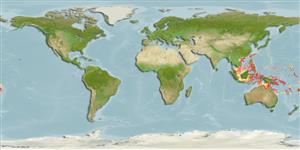Classification / Names
Common names from other countries
Main reference
Size / Weight / Age
Max length : 3.0 cm TL male/unsexed; (Ref. 90102)
Environment
Marine; demersal; depth range 10 - 120 m (Ref. 86942)
Climate / Range
Tropical, preferred ?
Distribution
Short description
Dorsal
spines
(total): 6 - 7;
Dorsal
soft rays
(total): 10;
Anal
spines: 1;
Anal
soft rays: 9 - 10. Characterized by pale grey body color with brown saddles on top of head extending ventrally to middle of preopercle, another across nape extending to pectoral region; presence of broad, dark brown lateral stripe from pectoral region to caudal fin base; fully united pelvic fins, frenum present; rounded caudal fin; longitudinal scale series 31-34; presence of barbels on snout, tip of chin, and ventrally below lower jaw; cycloid scales; cheek and opercle without scales; deeply embedded nape scales; absence of nasal and posterior interorbital sensory pores; depth of body 6.4 in SL (Ref. 90102).
IUCN Red List Status (Ref. 115185)
Threat to humans
Harmless
Human uses
More information
Common namesSynonymsMetabolismPredatorsEcotoxicologyReproductionMaturitySpawningFecundityEggsEgg development
ReferencesAquacultureAquaculture profileStrainsGeneticsAllele frequenciesHeritabilityDiseasesProcessingMass conversion
Tools
Special reports
Download XML
Internet sources
Estimates of some properties based on models
Phylogenetic diversity index
PD50 = 0.5001 many relatives (e.g. carps) 0.5 - 2.0 few relatives (e.g. lungfishes)
Trophic Level
3.1 ±0.3 se; Based on size and trophs of closest relatives
Resilience
High, minimum population doubling time less than 15 months (Preliminary K or Fecundity.)
Vulnerability
Low vulnerability (10 of 100)
Price category
